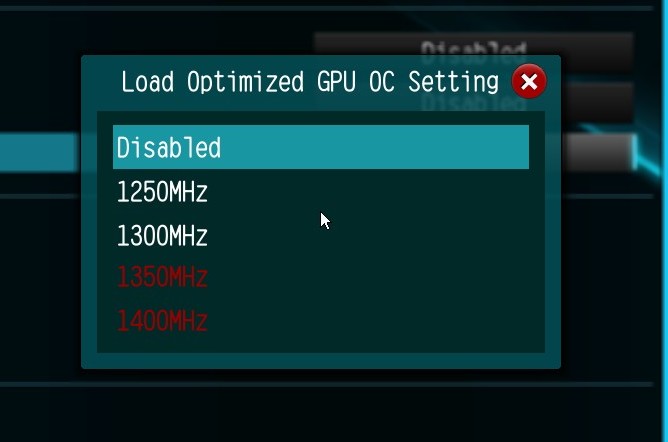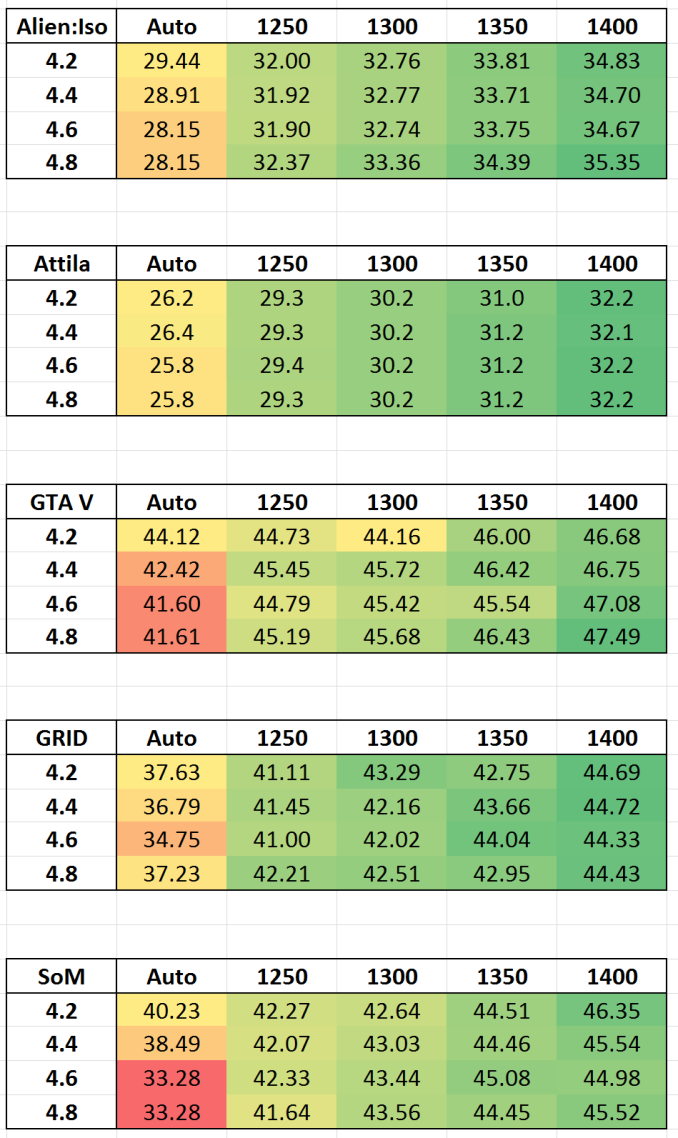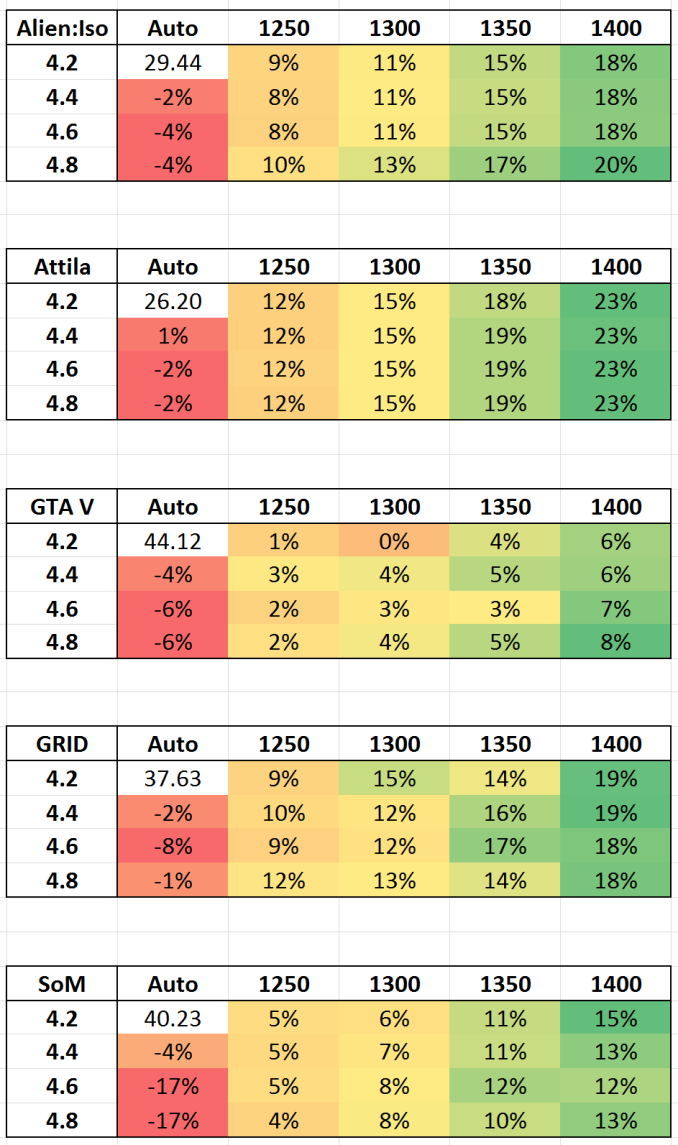The Intel Skylake i7-6700K Overclocking Performance Mini-Test to 4.8 GHz
by Ian Cutress on August 28, 2015 2:30 PM ESTGaming Benchmarks: Integrated Graphics Overclocked
Given the disappointing results on the Intel HD 530 graphics when the processor was overclocked, the tables were turned and we designed a matrix of both CPU and IGP overclocks to test in our graphics suite. So for this we still take the i7-6700K at 4.2 GHz to 4.8 GHz, but then also adjust the integrated graphics from 'Auto' to 1250, 1300, 1350 and 1400 MHz as per the automatic overclock options found on the ASRock Z170 Extreme7+.
Technically Auto should default to 1150 MHz in line with what Intel has published as the maximum speed, however the results on the previous page show that this is more of a see-saw operation when it come to power distribution of the processor. With any luck, actually setting the integrated graphics frequency should maintain that frequency throughout the benchmarks. With the CPU overclocks as well, we can see how it scales with added CPU frequency.
Results for these benchmarks will be provided in matrix form, both as absolute numbers and as a percentage compared to the 4.2 GHz CPU + Auto IGP reference value. Test settings are the same as the previous set of data for IGP.
Absolute numbers
Percentage Deviation from 4.2 GHz / Auto
Conclusions on Overclocking the IGP
It becomes pretty clear that by fixing the frequency of the integrated graphics, there is for the most part no longer the detrimental effect when you overclock the processor, or at least the reduction in performance to the same degree (which falls within standard error). On three of the games, fixing the integrated graphics to 1250 Mhz nets ~10% boost in performance, which for titles like Attila extends to 23% at 1400 MHz. By contrast, GTA V shows only a small gain, indicating that we are perhaps limited in other ways.














103 Comments
View All Comments
Impulses - Saturday, August 29, 2015 - link
Why would it make a difference? The BCLK is now decoupled from anything that would matter... It's just another tool like the ratio, one that could let you eke out an extra 50MHz or whatever if you really care to take it to the edge.Khato - Friday, August 28, 2015 - link
Two inquiries regarding future Skylake testing:1. While the initial review was intriguing in terms of actually exploring the DDR3L vs DDR4 2133 performance difference, higher DDR4 frequency testing is still absent. Will there be a memory scaling article at some point?
2. What's the point of evening including the discrete gaming benchmarks? Is there a plan to revamp this category of testing to provide meaningful data - inclusion of minimum frame rates, exploring different settings, using different games.
ImSpartacus - Saturday, August 29, 2015 - link
Yeah, it would be nice if we could get some proper frame time benchmarking.varg14 - Saturday, September 5, 2015 - link
I too would love to see High end DDR3L compared to DDR4 on skylake and if the tight timings of DDR3l are beneficial in what areas if at all.ImSpartacus - Friday, August 28, 2015 - link
I feel ridiculously shallow for asking this but could we see fewer tables that look straight out of excel going forward?Anandtech has a glassy table & graph design language. While it might be a bunch of excel templates, it still lets me suspend my disbelief a little bit more.
I can't justify my request with any tangible argument other than something "feels" off. I apologize as I understand how frustrating such feedback can be. I trust Anandtech to always be improving & setting the standard on all fronts.
ImSpartacus - Friday, August 28, 2015 - link
classy*garbagedisposal - Saturday, August 29, 2015 - link
They've used the same format a number of times before and it's pretty damn clear and easy to understand. Prettifying the excel tables on a mini article is a waste of time.ImSpartacus - Saturday, August 29, 2015 - link
You're right, this isn't an isolated issue. I didn't comment on it first time or the second time.And it's hard to tell someone who exhaustively tested numerous scenarios that they oughta spend even more time to ensure that they follow style guides and that the extra time spent won't even affect the utilitarian value of the results.
V900 - Friday, August 28, 2015 - link
Nice overview.But isn't overclocking in reality not really relevant anymore? A remnant of days gone by?
Dont get me wrong, I was an eager overclocker myself back in the day. But back then, you could make a 2-300$ part perform like a CPU that cost twice as much, if not more.
Today, processors have gotten so fast, that even the cheap 200$ CPUs are "fast enough" for most tasks.
And when you do overclock a 4ghz CPU by 600mhz or more, is the 5-10% speed increase really worth it? Most people would have been better off taking the hundreds of dollars they invested in coolers, OC friendly motherboards, etc and put them towards a better CPU instead.
Impulses - Friday, August 28, 2015 - link
There's a lot of people that just do it for fun, same way people mess with their cars for often negligible gains... Not all spend a lot on it either, I'd buy the same $130-170 mobo whether I was OC'ing or not, and I'd run the same $65 cooler for the sake of noise levels (vs something like a $30 212).